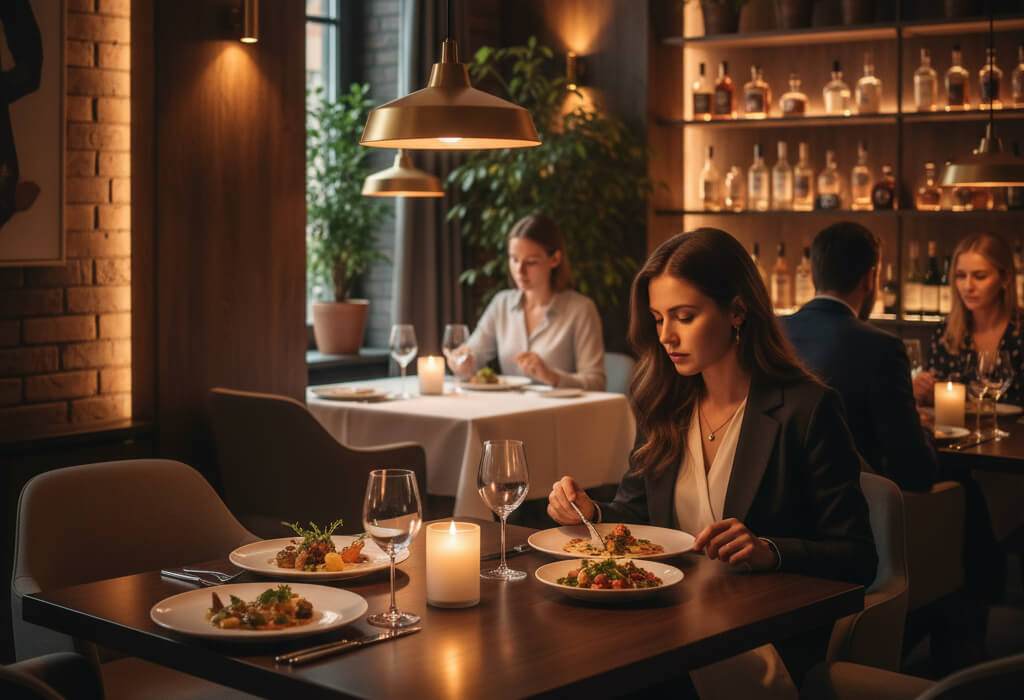October 06, 2025

Lighting is one of the most overlooked yet impactful elements of restaurant design. Beyond its aesthetic appeal, lighting directly influences customer mood, perception of food quality, length of stay, and even spending behavior. For restaurant owners, understanding the psychology of lighting is key to creating memorable dining experiences that turn first-time visitors into loyal patrons.
Lighting sets the emotional tone of a space — and often, diners decide how they feel about a restaurant before they even order. Warm, dim lighting tends to evoke comfort, intimacy, and relaxation. That’s why you’ll find it in upscale or romantic venues where longer stays are encouraged. On the other hand, bright, cool lighting fosters alertness and energy, making it ideal for fast-casual spots or lunch counters that rely on high turnover.
Supporting Data: A 2012 study from Cornell University found that diners in softly lit spaces spent more time eating, enjoyed their food more, and rated the ambiance more favorably — even when served identical meals to those in brightly lit rooms.
Pro Tip: Use dimmers to adjust lighting throughout the day — brighter during lunch service, softer during dinner. This flexible approach lets you align with both customer expectations and natural light availability.
As noted in The Most Common Restaurant Website Mistakes, your online photos and branding should reflect this ambiance to set accurate expectations and build consistency between digital and physical environments.
Customers often use subconscious cues to judge the quality of a restaurant. Lighting is one of the strongest of these cues. Sophisticated lighting — such as accent lighting on dishes or pendant lights over tables — can make meals feel more luxurious, even when prices remain unchanged.
Psychological Insight: Studies in environmental psychology reveal that diners associate ambient lighting with meal quality. Warm, indirect lighting often leads people to rate food as tastier and more expensive, even when the actual ingredients are the same.
Example: Chains like The Cheesecake Factory or upscale boutique restaurants use layered lighting — a mix of chandeliers, wall sconces, and LED accent lighting — to build a premium look that justifies their price points.
A high-quality lighting setup also improves how your food looks in customer photos and online menus, which is crucial given that 60%+ of diners browse menus online before booking. As RocketPages shares in The Cost of Not Having a Website, poor digital presentation erodes trust — even before guests set foot in your restaurant.
Lighting doesn’t just affect feelings — it shapes behavior. Strategic lighting can:
Example Use Case:
Revenue Impact: According to research published in the Journal of Retailing and Consumer Services, appropriate ambient lighting can increase perceived meal value, which can boost average ticket sizes by 10–15%.
When paired with smart retention strategies — like loyalty programs that actually work — this creates a cycle of longer stays, increased spending, and more return visits.
Lighting also plays a role in your digital performance. Well-lit interiors improve the quality of user-generated content (UGC) on platforms like Instagram, where visuals heavily influence restaurant discovery.
Smart Integration Ideas:
As RocketPages explains in POS Integration and Smart Kitchens, integrating digital tools with lighting systems enhances efficiency and can even automate ambiance adjustments based on service pace or time of day.
Finally, showcasing your lighting setup in your Google listing and review galleries — paired with good reviews — reinforces brand quality. See How Reviews Impact Restaurant SEO for more on the connection between visuals and customer trust.
Every restaurant has a story — and lighting can help tell it. Are you modern and sleek, rustic and homey, or luxurious and refined? Your lighting choices should reinforce that identity:
Ensure this identity carries into your digital assets as well. Your website design, imagery, and even color palette should reflect the same tone, as emphasized in Restaurant Branding 101.
Brand Recall Tip: Cohesive lighting and branding help customers remember your restaurant — which boosts repeat visits and social sharing.
Lighting preferences can vary across customer segments. Families with young children may prefer brighter seating areas, while couples may seek more intimate, candle-lit corners.
Use your website or post-visit email surveys to ask guests:
Integrating this with your CRM and loyalty data — like in How to Use Your Website to Collect Customer Emails and Build Loyalty — helps tailor future dining experiences to individual preferences.
Lighting is more than just decoration — it’s a strategic lever that influences perception, behavior, branding, and ultimately, profitability. From the warmth of a table lamp to the glow of an online image, the right lighting creates memorable experiences that diners share, return for, and talk about.
By aligning your physical lighting strategy with your online branding, smart technology, and customer feedback tools, you’ll create a restaurant environment that delights guests — both in person and online.
Stay up to date with the latest tips, expert insights, product reviews, and step-by-step guides to help you grow, create, and succeed—no matter your industry or passion.